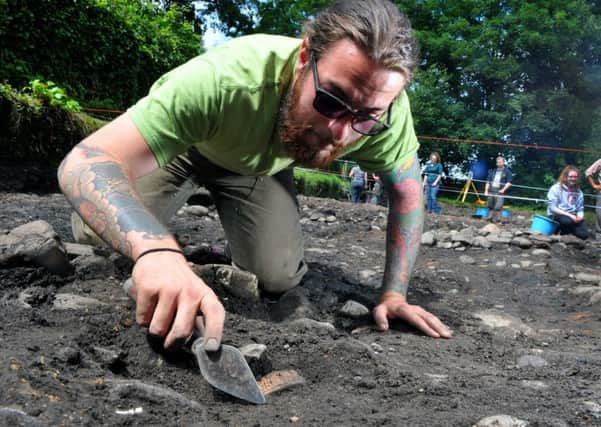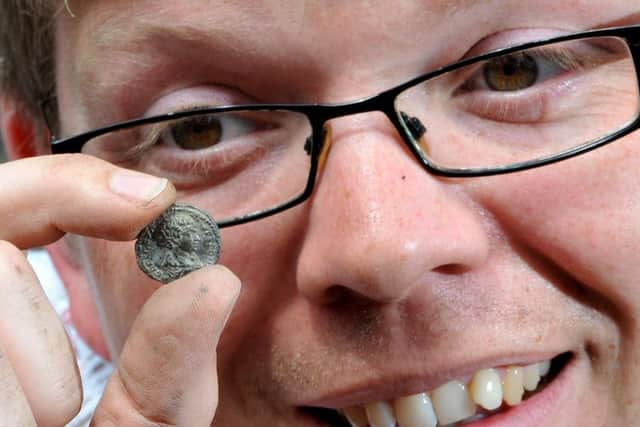It's Ribchester Re-visited for UCLan team


A new army of occupation has descended on Ribchester.
The hardworking team of 50 set up camp in the historic Ribble Valley village on the banks of the River Ribble just over three weeks ago.
Since then they have been on a special mission. Their target is treasure - archaeological treasure and their tools are simple - trowels, mattocks, which are similar to small pickaxes, and shovels.


Advertisement
Hide AdAdvertisement
Hide AdBut their ambition is not so much to find treasure in the conventional sense but to unpick the mysteries of how Ribchester developed in the years during and towards the end of the Roman occupation. The Romans arrived in 72AD and stayed until around 410 AD and although a megafind would be much appreciated every little piece of pottery, broken metal work or discovery of a coin helps this dedicated team put together a bigger picture.
This is the third year archaeology students from UCLan have been working in the village. They have coped with soaring temperatures and chilling rain, camping in a nearby field.
Patience and persistence are needed in abundance.
This year wearing distinctive green Ribchester Re-Visited T-shirts the team has dug deeper and is now just 20cm from the level of the nearby Roman bathhouse remains.


The Dig’s Co-Director Dr James Morris, lecturer in archaeology, said: “We used to think Ribchester was abandoned (by the Romans) in 350 AD but now we’ve got evidence this isn’t the case. We’ve got evidence which means they were here until the end of and beyond the Roman period. We’ve got coins and pottery that date to the end of the 4th century.”
Advertisement
Hide AdAdvertisement
Hide AdStanding near a reddish patch of soil which it is believed is where a flue for a furnace stood he states: “There’s a building underneath this. This is the (evidence of) the reuse of a building in the late Roman period. It was a workshop (fabrica) making not just military items but possibly everyday metal items.”
Evidence of trace gold, silver and mercury in microscopic amounts in the soil indicate there was decorative intent too.
Dr Morris said: “The fact there was silver, gold and mercury would suggest gilding. This is at the end of the Roman period in Ribchester. We’re talking about microns, about trace elements in the soil, not about lumps of gold.”
Now the full dimensions of the wall surrounding a key part of Ribchester’s Roman fort have been uncovered. Near to where the north eastern guard chamber would have stood the wall remainsare two metres wide, with a clay bank behind of some eight metres.
Advertisement
Hide AdAdvertisement
Hide AdDr Morris continued: “We have had a large number of Roman coins which is great for allowing us to date the evidence. We’ve had shale and jet bracelets. They nicely show evidence that though everyone thinks of Ribchester as a male space, a fort, that’s probably not actually the case. We’ve had brooches. Actually we have had very little in military artefacts at this stage. Probably because we’re in the late Roman period the fort was changing from a pure military base to much more a centre for the community. It’s becoming perhaps more of a market place within part of the fort.”
This year there have also been more clues to what Dr Morris terms “Roman Brexit.”
He said: “What we didn’t know was the activities that were taking place in this part of the fort. What we have at the end of that Roman time period is the collapse in international trade.
“The empire is losing its centralised control and the local area is becoming much more important...in effect independent. It’s a time period archaeologists and historians don’t know that much about.”
Advertisement
Hide AdAdvertisement
Hide AdThe 2017 dig has had a distinctively international reach. It is a collaboration between UCLan, Ribchester Roman Museum, the Australian National University (ANU) and the Institute of Field Research. Dr Morris has worked with site co-director Dr Duncan Sayer, reader in Archaeology at UCLan, and Dr Ash Layton, lecturer at ANU.
Of the students some 20 came from UCLan, 11 from Australia and seven from American universities. The students have also been joined by volunteers, including members of the Friends of Ribchester Roman Museum.
Second year student Mark Denham was acting as enthusiastic guide when the Post visited. It’s his third year on site as he first joined the team straight after taking his A levels.
On Saturday (July 15) there will be a farewell Dig Open Day with a director’s site tour at 3.30pm and a talk in the village hall from 4.15pm. The site itself will be open from 11am.
Advertisement
Hide AdAdvertisement
Hide AdThe entrance to the excavation is by St Wilfrid’s church off Riverside. Dr Morris added: “The village has been utterly fantastic and the local community is always really warm and welcoming.”
Asked how he feels about packing up so soon he acknowledges that another year’s wait to continue the dig ”is slightly frustrating” but next year it is confidently predicted there will be many more exciting discoveries waiting to be made.